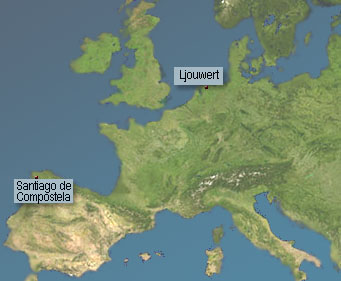
 rom the far north of The Netherlands to the extreme west of Spain is a long way,
but every year an increasing number of people cycle or even walk the more
than three thousand kilometer long Saint Jacob’s pilgrim-path: from St Jabik
to Santiago de Compostela (both of which mean Jacob in the local languages).
Some enthusiasts cycle the entire route in six weeks, covering a hundred
kilometers a day, six days a week for six weeks. And that’s just getting
there: most have to cycle back as well. Walking at a fair clip you’d cover
about thirty five kilometers day, which means that it would take at least
a hundred days to make it. In any case, whether you walk or cycle, it’s a
bloody long way. For the less devout, there is, of course, another approach.
Fundamentally it is a game of collecting stamps from checkpoints in a number
of participating towns and cities along the route. Unless you are trying
to achieve redemption, there is no reason to complete the entire course in
one go. Many tourists now undertake sections at a time, coming back year after year to complete another
section, gradually working their way south or north.
rom the far north of The Netherlands to the extreme west of Spain is a long way,
but every year an increasing number of people cycle or even walk the more
than three thousand kilometer long Saint Jacob’s pilgrim-path: from St Jabik
to Santiago de Compostela (both of which mean Jacob in the local languages).
Some enthusiasts cycle the entire route in six weeks, covering a hundred
kilometers a day, six days a week for six weeks. And that’s just getting
there: most have to cycle back as well. Walking at a fair clip you’d cover
about thirty five kilometers day, which means that it would take at least
a hundred days to make it. In any case, whether you walk or cycle, it’s a
bloody long way. For the less devout, there is, of course, another approach.
Fundamentally it is a game of collecting stamps from checkpoints in a number
of participating towns and cities along the route. Unless you are trying
to achieve redemption, there is no reason to complete the entire course in
one go. Many tourists now undertake sections at a time, coming back year after year to complete another
section, gradually working their way south or north.
The path starts in St Jabik (called Sint
Jacobiparochie in Dutch), a small village in the far north in the semi-autonomous
area called Fryslân. I know the area very well because it is where I spent the summers of my childhood.
It is an idyllic place, perfect for children; consisting of stunningly beautiful
little villages, an icy cold sea and magnificent open farm lands. But these
days appearances can be deceptive: in reality the charming cottages and the
smaller farms have nearly all been bought by Dutch and German retirees who
have done wonders in restoring the buildings but have also in many cases
unwittingly killed off village life. The Dutch writer Geert Mak summed up
the shift by declaring that God had abandoned the villages. The claim gives
a good indication of not only the changing demographic but also of the importance
of religion to the Frisians.
Every village, no matter how small, has a church. But churches can’t
operate when the largest part of their congregations only visits for three
weeks in the summer. Preachers often now come once a month, rather than twice
a week. The church seems to be as much a victim of Economic Rationalism as
the small farmers forced off the land have been. Despite all that, a clear
sunny day lends credibility to the Frisians’ unshakeable belief that theirs
is the best country on Earth.
The Frisian people have lived in the area since time immemorial and
show no signs of leaving. They have their own language, their own culture
and most of all their own unique way of seeing the world, particularly in
religious terms. In fact they were the last of the mainland Europeans to
withstand the Christian Evangelists: St Boniface was unceremoniously slain
in Dokkum on the fifth of June, 754, when he tried to bring the new religion
from England to the fiercely independent heathens who had contemptuously
withstood all attempts at religious subjugation. At that time the Frisian
people put their faith in the more earthy deities like Woden, Frig and Eostre:
after all, this was (and continues to be) a land of farmers and fishermen
who need the Earth and the Sea to be, if not always bountiful, at least not
actively antagonistic. Even today the only things the world seems to know
about Fryslận are its black and white cattle and the beautiful jet black
horses that the Duke of Edinburgh uses to compete with in Olympic Games.
But the juggernaut of Christianity could not be resisted forever and
eventually the Frisians succumbed. These days only remnants of the old religion
remain. The God Woden continues to be remembered through Wednesday and the
Goddess Eostre through Easter, her festival that was taken over by the Christians
and recast as the time when Jesus was crucified. Wherever they went, the
Christians were good at taken over existing festivals and attaching Episcopalian
significance. But occasionally on a mid-summer’s night, when a full moon
hangs heavy in the vast sky, some folk swear they can feel the spirits of
their ancestors whispering to them in the old language.
Frisians tend not to do things by halves and when they were eventually
converted they took to the new religion with the same fierce single-mindedness
with which they had defended the old. Bear in mind that the Frisians have
a well-deserved reputation for maintaining their independence. The Romans
gave up trying to conquer them, and later even the all-conquering Charlemagne
allowed them to remain their own masters. So, when the new religion took
hold, they embraced it without reservation but with plenty of criticism.
Unhappy with the pomp and ceremony (and corruption) that was increasingly
evident in the Papish version, they adopted the pragmatism and egalitarianism
of the Calvinists. Religion for those whose welfare depends upon good fortune
is a serious business. As an indication of their approach, Menno Simmons,
founder of the Mennonites who continue to maintain their old fashioned ways
even today, was a Frisian. So it should come as no surprise that these fiercely
independent and pragmatic people should take a special interest in Jacob, a dour and serious Apostle
who also happened to be a fisherman. He at least would understand the weather
and the seasons.
Most English speaking people know him as Saint James because in the
New Testament that is what he is called. In the Old Testament however, he
is called Jacob, and the Frisians prefer the fire and brimstone certainty
of the original to the pumped-up pageantry and subject-to-interpretation
parables of the new, so here he is known as Sint Jabik. Linguistically, the
Frisian didn’t think much of the language shifts of the seventeenth century
either, so the b and the k sounds stayed where they originally were, unlike
in that new-fangled English, Dutch and German.
At the other end of the Path, he is known as Sant Iago, a fact which
for people raised on Shakespeare, often causes a quizzically raised eyebrow.
Curiously, Saint Jacob is known in Spain as the Moor-slayer, and in the play
it was Iago who plotted the Moor of Venice’s tragic downfall. But whilst
Sant Iago is generally considered a good guy (and his Moor-slaying is played
down these days), Iago was the bad guy in the play and, technically, Othello
killed his wife and himself as a result of his jealousy. But it does make
you wonder.
Along with his brother John, Jacob was one of Jesus’ favoured apostles.
It was widely believed that after Jesus’ death, Jacob was sent to Finisterre
(literally “the Ends of the Earth”) to spread the gospel. Heading west from
Galilee, he walked until he came to Galicia, the area of Spain on the Atlantic
Ocean, just above present-day Portugal. That was as far as he could go without
falling off the edge of the world. Perhaps he should have tried because a
few years later back in Jerusalem, he was beheaded by King Herod. His bones
were spirited back to Galicia, and in the eleventh century a magnificent
cathedral was built over his grave in Santiago de la Compostela, which still
stands and now serves as the end point for pilgrims on the Path. As the country’s
patron saint, Jacob is generally revered throughout Spain, but nowhere more
than in Galicia.
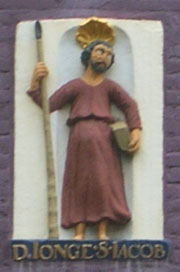 In
the medieval context, pilgrimages were common-place all over the world. Europe
was no exception: long before Jacob’s bones were buried in Santiago, many
cities and towns had “pilgrim routes” leading to holy places. The idea was
that the physical journey mirrored the spiritual one that the soul would
take to get to Heaven. Some of the routes were quite short, such as to the
shrine of Beckett in Canterbury (where Chaucer’s pilgrims were off to in
his Canterbury Tales) and others were very long such as the trip to Jerusalem. Some were to graves,
such as the Vatican City where late in the twentieth century Pope Paul VI
accepted the bones unearthed from under the Basilica of Saint Peter as those
of the venerable apostle, and others were to places were miracles had occurred,
such as Lourdes where Saint Bernadette saw visions of Mary. In most cases,
the reason for the trip was to ask either for forgiveness or favour from
God.
In
the medieval context, pilgrimages were common-place all over the world. Europe
was no exception: long before Jacob’s bones were buried in Santiago, many
cities and towns had “pilgrim routes” leading to holy places. The idea was
that the physical journey mirrored the spiritual one that the soul would
take to get to Heaven. Some of the routes were quite short, such as to the
shrine of Beckett in Canterbury (where Chaucer’s pilgrims were off to in
his Canterbury Tales) and others were very long such as the trip to Jerusalem. Some were to graves,
such as the Vatican City where late in the twentieth century Pope Paul VI
accepted the bones unearthed from under the Basilica of Saint Peter as those
of the venerable apostle, and others were to places were miracles had occurred,
such as Lourdes where Saint Bernadette saw visions of Mary. In most cases,
the reason for the trip was to ask either for forgiveness or favour from
God.
Most cities have their own favourite or patron saint, but Jacob continues
to hold a special place in all of Western and Northern Europe—and there are signs of the reverence for him throughout the area. All cities
have at least one street named after him, and Ljouwert, Fryslân’s charming capital city, is no exception. It is very pleasant to wander around
this beautiful little city; looking at the many small reliefs that adorn
the older houses that are now being restored. Particular to this story, you
can find one that shows a young Jacob on his way. We know it is him because
it says so in Dutch and because the four traditional symbols of the pilgrim
are clearly evident: the staff, the Bible, the shell above his head and the
tunic (which would later become the cloak or mantle).
Elsewhere, high on the walls of the city’s Catholic Church, built
in 1254, one of the murals 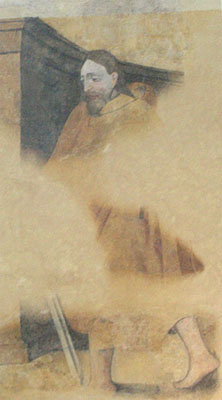 shows a somewhat older Jacob on his way through Europe spreading the gospel.
The image is fading, but it is still very evident as to who it is. The fact
that Jacob looks more like a Teutonic gentleman striding to a business meeting
than a Middle Eastern mystic determined to spread the gospel to the pagans
indicates that the mural was painted in the seventeenth century, when the
city was an important part of the Hanseatic League. For many centuries the
Frisian language was the lingua franca of business and economics for most
of Northern Europe. It was the successful business men who sponsored the
building and decorating of the churches and cathedrals, and they wanted to
be able to see themselves in the holy men painted on the walls.
shows a somewhat older Jacob on his way through Europe spreading the gospel.
The image is fading, but it is still very evident as to who it is. The fact
that Jacob looks more like a Teutonic gentleman striding to a business meeting
than a Middle Eastern mystic determined to spread the gospel to the pagans
indicates that the mural was painted in the seventeenth century, when the
city was an important part of the Hanseatic League. For many centuries the
Frisian language was the lingua franca of business and economics for most
of Northern Europe. It was the successful business men who sponsored the
building and decorating of the churches and cathedrals, and they wanted to
be able to see themselves in the holy men painted on the walls.
Although the style of the mural is very different to the relief, the pilgrim’s
accoutrements are still in evidence—at least in part. The staff has been replaced by a sword (this was the times
when Christians were encouraged to consider their struggle against the heathens
in more military terms) and the tunic is well on the way to becoming a cloak.
On his back he carries a bag, presumably holding his bible. The shell has
disappeared, probably somewhere in the faded sections that now seem to swathe
Jabik in atmospheric mist.
With so many signs and portents, it seemed churlish for me not to make a start.
So with a guidebook (rather than a Bible) in hand, wearing a windcheater
(rather than a cloak), but with a shell (from South Melbourne Beach) in my
pocket, I left the town of St Jabik to set foot on the path to Heavenly redemption.
Although I had neither favour nor forgiveness to ask, it seemed as good a
way as any to take a closer look at the changeable landscape of my childhood.
If nothing else, it was an excuse to get some fresh air and to think about
a few things. And to prove I had done so, along the way I would collect stamps
in the back of my guidebook.
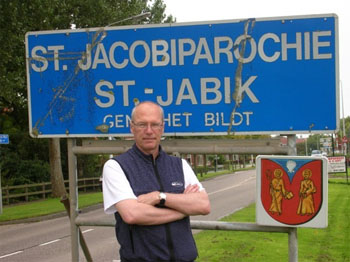 To
my left, under the main sign, is a smaller one showing two bearded men. They
are carrying the traditional pilgrim symbols: the staff, the Bible and the
mantle. Above, splitting the two characters is a shell. Rather than a conch,
it is a scallop shell. In Frisian the word for shell is “skulp”, pronounced
much like the English word “scallop”, which in turn is called “St Jacques’
coquille” in French. Not very surprising really, seeing Frisian and English
were the same language nine centuries ago.
To
my left, under the main sign, is a smaller one showing two bearded men. They
are carrying the traditional pilgrim symbols: the staff, the Bible and the
mantle. Above, splitting the two characters is a shell. Rather than a conch,
it is a scallop shell. In Frisian the word for shell is “skulp”, pronounced
much like the English word “scallop”, which in turn is called “St Jacques’
coquille” in French. Not very surprising really, seeing Frisian and English
were the same language nine centuries ago.
But translating between the two can create problems. The northern
most point of the Path is just outside the town of St Jabik, in the tiny
village called Zwarte Haan in Dutch, which translates to English as Black
Rooster. However in Frisian it is Zwarte Hoane, which translates into English
as Black Hook. The latter makes much more sense because it is a hook of black,
peaty clay, and there no black roosters to be seen anywhere. But despite
the name of the place having nothing to do with poultry, the stamp you collect
at the restaurant is of a black rooster.
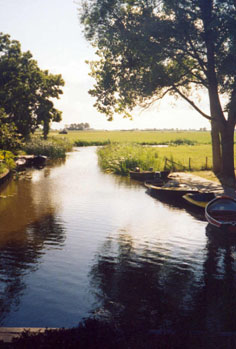 One
of the most interesting of the tales that are attached to St Jacob’s Path
is the possibility that the first person to walk the route was a clay-worker
from this area. The story goes that the chap managed to get himself into
a fair bit of strife with one of the local women, without the sanctity of
marriage. The local priest was called in to hand out an appropriate punishment.
The problem was that the fellow’s family owned much of the land, so the sentence
couldn’t be too severe. The priest opted to send the young man on a pilgrimage
to Santiago de la Compostela, a task that would keep him out of sight for
a while and might just settle him down If nothing else, he’d be tired when
he came back. He was allowed to take no food or money or water, and had to
collect a signed letter of arrival from the Spanish church. He was allowed,
however, to take his girlfriend—which makes sense because you can ask for food, water and a place to sleep along
the way but asking for someone to sleep with is slightly more problematic.
As legend would have it, the young man died just before arriving in Galicia,
leaving his girlfriend to collect the letter and walk back. There’s a moral
in there somewhere.
One
of the most interesting of the tales that are attached to St Jacob’s Path
is the possibility that the first person to walk the route was a clay-worker
from this area. The story goes that the chap managed to get himself into
a fair bit of strife with one of the local women, without the sanctity of
marriage. The local priest was called in to hand out an appropriate punishment.
The problem was that the fellow’s family owned much of the land, so the sentence
couldn’t be too severe. The priest opted to send the young man on a pilgrimage
to Santiago de la Compostela, a task that would keep him out of sight for
a while and might just settle him down If nothing else, he’d be tired when
he came back. He was allowed to take no food or money or water, and had to
collect a signed letter of arrival from the Spanish church. He was allowed,
however, to take his girlfriend—which makes sense because you can ask for food, water and a place to sleep along
the way but asking for someone to sleep with is slightly more problematic.
As legend would have it, the young man died just before arriving in Galicia,
leaving his girlfriend to collect the letter and walk back. There’s a moral
in there somewhere.
 Whereas
the southern end of the path has its famous cathedral, the northern end has
vast empty spaces, especially above you. When you are walking in the meadows,
the sky stretches over you like an enormous snow-cone and every now and then
a celestial hand gives it a shake. Driven by the winds from the Arctic north,
black rain-clouds roll down, stealing the light and occasionally dumping
fat showers exclusively where you happen to be. What ever the season, take
a raincoat: a sleeveless windcheater over a t-shirt just doesn’t cut it.
Trust me on that. On the other hand, showers do pass quickly and if you keep
walking you dry out quickly.
Whereas
the southern end of the path has its famous cathedral, the northern end has
vast empty spaces, especially above you. When you are walking in the meadows,
the sky stretches over you like an enormous snow-cone and every now and then
a celestial hand gives it a shake. Driven by the winds from the Arctic north,
black rain-clouds roll down, stealing the light and occasionally dumping
fat showers exclusively where you happen to be. What ever the season, take
a raincoat: a sleeveless windcheater over a t-shirt just doesn’t cut it.
Trust me on that. On the other hand, showers do pass quickly and if you keep
walking you dry out quickly.
Following the old church paths that still give the pedestrian the
right of way, the Path bumps against little waterways where small sailing
boats nestle under willow trees, over paddocks where the Frisian cows graze
contentedly on the lush green grass and through old villages with two names:
first in the local language, then in Dutch. Often it is in the churches or
the nearby community centres that you collect your stamps, and stop for a
chat. Nearly every one speaks English, and if you come from Australia, New
Zealand or Canada, they will enquire if you know any of the various members
of their family who migrated there in the last fifty years.  Like Ireland, there are now more Frisians living abroad than in Fryslân.
Like Ireland, there are now more Frisians living abroad than in Fryslân.
The last place on the Path before you get back to Ljouwert is a beautiful
little village called Stiens. Its centre piece (literally and figuratively)
is one of the most beautiful sixteenth century churches still operating.
Surrounded by a ring of verdant trees that from a distance look like a green
ruff, it remains the social and spiritual centre of village, and anyone who
was anyone is buried either inside or in the graveyard. So beautiful and
so close to the city, the little houses were bought and restored by the commuters
rather than the original villagers.
Back in Ljouwert, after a final stamp, it’s time for a well-deserved
beer in a café in St Jacob Street. From here it’s not so far to Spain, and
should you wish to continue, simply look at the seven man-hole covers in
the middle of the cobble-stoned street. Each has stamped on it a variation
of the shell theme and bears the Latin words campus stellae, the field of
stars. Line all up all seven and they will point the way Santiago de la Compostela.
But be careful of the traffic—it’s getting crowded on Sint Jabikspaad.

